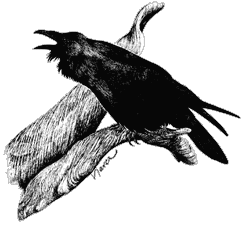Common Raven
Members of the corvid family, including ravens, crows, jays, and magpies, are thought to be among the most intelligent of birds. If adaptability is any sign of intelligence, then the Common Raven must rank as a superstar: it thrives from Siberia to North Africa, from arctic Alaska to the mountains of Central America. Forest, tundra, and desert are all within its realm. Technically it is classed as one of the songbirds, or perching birds, but it is larger than many hawks, and it will feed as a predator or scavenger as the opportunities arise.

In the southwestern U.S. and northern Mexico, Common Ravens range from sea level (along the Gulf of California) to the mountaintops. They can even be seen flying over desert cities, their croaking calls floating down from the sky as the big birds flap overhead. Unlike the Chihuahuan Raven—a smaller and more sociable bird that lives in grasslands along the eastern edge of our region—Common Ravens seldom travel in flocks, but members of a pair may stay together at all seasons. Their nesting sites are sometimes in large trees, where these are available, but most raven nests in the Sonoran Desert are placed on high cliffs. —Kenn Kaufman
Common Raven (Corvus corax)
Order: Passeriformes
Family: Corvidae (Crows, Jays, Magpies)
Spanish names: cuervo grande, cuervo holárctico
Distinguishing features
A hawk-sized, shiny, black bird with a black bill and a wedge-shaped tail. The Common Raven is the largest member of the order Passeriformes (the songbirds, or perching birds).
Click to hear the sounds of the Chihuahuan Raven
Click to hear the sounds of the Common Raven
Click to hear the sounds of a Crow
Habitat
This intelligent and very adaptable bird occurs from low deserts to mountains, over open desert areas to dense forests.
Feeding
• Diet: Omnivorous; diet may include carrion, reptiles, amphibians, bird eggs, insects, and plant matter.
• Behavior: Opportunistic feeders, ravens often take food wherever it can be found, including public landfills; also frequently search for nests where they feed on the eggs; sometimes hunt in pairs where one bird flushes out the prey. Their water-rich diet of carrion, insects, and eggs, along with their stocky bodies, which help them better regulate their body temperature, allow this species to cope with the desert’s heat.
Life History
Courtship involves the male soaring, swooping and tumbling in front of the female. The pair also soar together, then perch and preen one another. Ravens mate for life.
Nesting takes place from February to May in this region. The nest, which is usually built hight in a tree or on a precipice, is a platform made of large sticks, twigs and vine stems with a deep depression in the center; it is lined with grasses, animal hair and mosses. Usually 4 to 6 greenish blotched eggs are laid; incubation is by the female. The male feeds the female during the 3 week incubation period. The young are altricial; they leave the nest about 5 weeks after hatching.
A Matter of Style
The folklore of more than one group of native Americans includes stories about coyote and raven interactions. I witnessed such an encounter early one morning while walking the banks of the Rillito River near Tucson. Two ravens were in the center of the dry riverbed, actively complaining. About five feet from them was a coyote, nose to the ground, casually sniffing about. Evidently located between the two groups was an object—possibly a bit of food—that all three coveted.
The ravens asserted themselves through noise and occasionally hopping about, but never getting too close to the canine. The coyote’s approach to the matter was completely the opposite: he simply did not acknowledge the birds’ presence. He never looked at them. He made no move in their direction. One could almost hear him mutter, “I don’t see anything. Do you see anything? I don’t see anything.”
Eventually the coyote trotted down the riverbed, apparently oblivious to the ravens’ continued harangue. It seemed as though both coyote and ravens had forgotten whatever object it was that had sparked the debate, the coyote possibly believing he was the victor in this confrontation by his superior demeanor, and the ravens believing they were the winners by raucous strength of voice.
—Peggy Larson, naturalist and author









